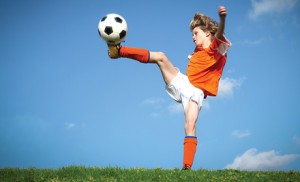David Beckham’s got nothing on your kid when it comes to his soccer skills, even coaches are impressed with his ability and love for the game. So it makes perfect sense to let him play the sport he so enjoys to his heart’s content, even finding ways to play year-round in indoor leagues and summer training camps, right? Maybe not. Your kid could be setting himself up for an overuse injury.
What is an Overuse Injury?
An overuse injury is pretty much exactly that — an injury that happens when a particular body part is used repetitively.
“An overuse injury is distinguishable from a traumatic injury like a break or a sprain,” says Matthew DesJardins, M.D., a physician with Commonwealth Orthopaedic Centers. He explains that an overuse injury is characterized by developing pain or dysfunction due to repetitive action — knee pain in a runner, elbow pain in a young pitcher, or shoulder pain in a swimmer are a few examples.
Causes and Concerns
DesJardins says that overuse injuries are due to a couple different reasons. Kids participate in more organized sports versus free play, he says, explaining that organized sports can involve a lot of repetitive drills — repeating the same action time after time. And while options are plentiful when it comes to youth athletics, a growing trend is specialization in only a couple of sports, or even just one.
“Kids are specializing earlier than they used to,” says DesJardins, adding that kids who used to play sports seasonally and relax during the summer are now focusing on only one sport in year-round fashion. Outdoor soccer becomes indoor soccer in order to extend the season, and hence, a player doesn’t use muscle groups that he would if he played a different sport for a while.
At the same time, kids are susceptible to overuse injuries because they’re still growing. According to the American Academy of Orthopaedic Surgeons (aaos.org), growth plates — areas of cartilage found at the ends of bones that are the last pieces to ossify, or harden — are particularly vulnerable. These areas are weaker than nearby tendons and ligaments and when injured, can affect the bone’s growth.
Treatment and Prevention
The good news, according to DesJardins, is that overuse injuries aren’t usually serious when treated early, and improve with rest.
“Rest is the front line of treatment,” he says, adding that this doesn’t mean your child needs to sit on the couch for a month. A pitcher can still bat or play another position, or a dancer might need to avoid certain positions while still dancing. It’s all about taking a break, and restricting practice for a while. This is a good time to visit with a specialist like DesJardins — someone who understands the mechanics necessary to a child’s chosen sport and who can help the athlete and his parents develop a plan to return to play. It’s also a good time to explore other activities.
“I strongly recommend to parents that even if their kids excel at a sport, to let them explore other sports. I encourage them to have broad interests,” says DesJardins, pointing out that even today’s professional football players didn’t necessarily specialize in football when they were growing up. He advises parents to avoid signing up for year-round sports, and if your kid does play a single sport, to impose a rest season. “Let your body rest, let your mind rest,” he says. Rest will help your kid keep his head in the game just as much as his body.





